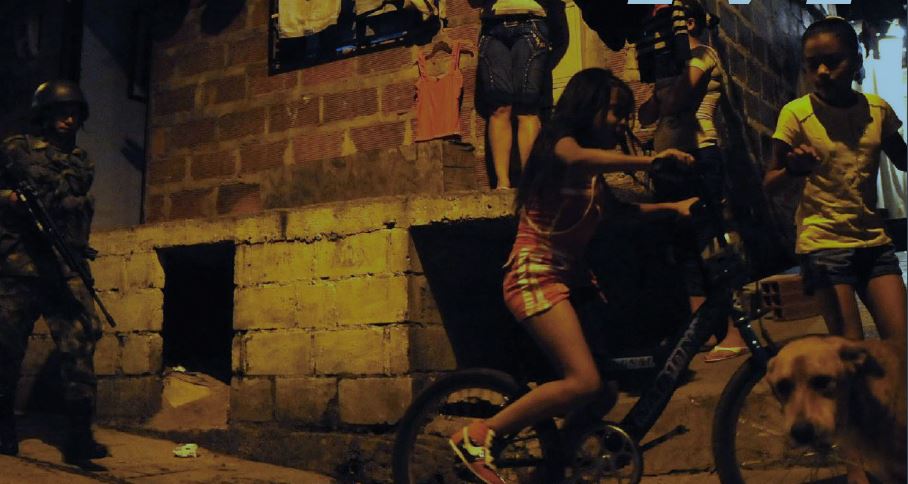
This article originally appeared in the September/October 2018 issue of Museum magazine.
The city, once beset by violence, is using its public spaces and cultural institutions to transform itself.
This article is adapted from Juan Luis Mejía Arango’s keynote speech at Reimagining the Museum: Conference of the Americas, held in Medellín, Colombia, in November 2017. The conference was co-produced by the American Alliance of Museums and the TyPA Foundation in partnership with the host organization Parque Explora.
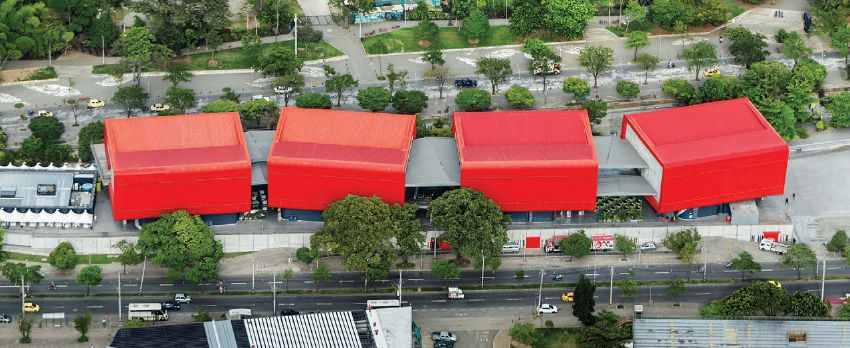
“Medellín, an urban palimpsest.” This metaphor helps illustrate the evolution of the city. Because all cities, somehow, are like a medieval scroll upon which texts are written and then erased, and where previous writings that we considered long-lost may reemerge.
Medellín lies in the northern part of South America in the Antioquia department of Colombia. It has access to the sea through the Gulf of Darién and is located between three valleys: one to the east, more than 2,000 meters above sea level; another between 1,400 and 2,000 meters above sea level; and a third, toward the Cauca river watershed, between 700 and 1,000 meters above sea level. The Cauca river is a key geographical element to our history since its waterfalls marked the industrial calling of the city. It explains why Medellín, almost 1,000 kilometers away from the seaports, became the industrial hub of the country.
A Brief History of Medellín
During Spanish colonial times, the city was isolated, sinking into poverty—it had no more than 50,000 inhabitants and no important trade routes. Between 1915 and 1948, significant numbers of the peasant population came to the city, transitioning from the craft sector to the working class. These immigrant communities started to transform cultural consumption. Many became tango enthusiasts, adopting this type of music as a form of expression.
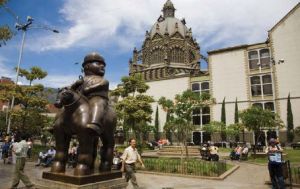
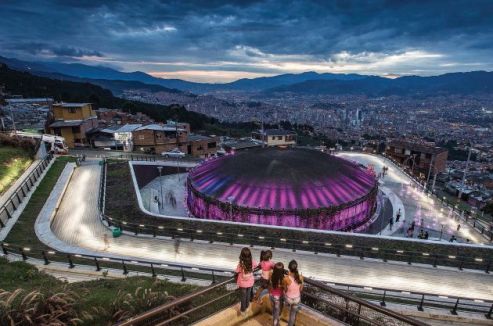
In 1948, the city hired a group of experts—disciples of Le Corbusier, including Josep Lluís Sert, the great Catalonian architect, and Paul Lester Wiener—to create a plan for the city, which at the time had 350,000 inhabitants. They designed a city to accommodate twice as many people.
However, two phenomena occurred. The first was the beginning of a period of political violence between conservative and liberal parties. This violence mostly affected the countryside, causing migration to the cities. The second was an important change in the economic development model of Latin America, known as the cepalino model, which was characterized by a mild industrialization process, the substitution of imports, and an accelerated urbanization process. These phenomena contributed to the city’s overpopulation and social fragmentation.
Informal and spontaneous development processes emerged and, in turn, state leadership evolved from being proactive to reactive.
In the early 1960s, the rampant population growth in the city spread to the northeastern mountainside. This area was populated by peasants who migrated from the countryside looking to resettle in Medellín. The city expanded without urban planning, with a diversity of basic houses built by the migrants.
During the 1980s, several factors converged to create a “perfect storm.” The valley grew in a disproportionate way, swelling to one million inhabitants struggling to prosper under the cloud of an outdated economic model—a consequence of import restrictions, obsolete industry, and technological deficiencies that signaled a lack of international competitiveness.
Finally, the scourge of drug trafficking settled in. It became a financial substitute that challenged governance. It didn’t take long before chaos erupted: drug trafficking, organized crime, and political violence. Unemployment soared, and drug trafficking, with its increasing power, controlled the state. This crisis, however, shaped a movement that focused on finding alternatives for the future.
The 1990 film Rodrigo D: No Futuro perfectly illustrates this historical moment. It depicts how young people risked their lives as the result of escalating gang activity, crime, and guns. During that time, so many young people were murdered, and society succumbed to unrelenting violence. In 1991, Medellín held the world record for homicides—368 per 100,000 inhabitants—even outpacing the death toll in the Beirut war. Pablo Escobar, with his criminal machine, unleashed a frontal war against the state, and paramilitary groups strengthened. (Today, the homicide rate has dramatically declined to 19 per 100,000 inhabitants and murders are more frequently attributed to interfamily and neighborhood conflict than gang violence.)
The Transformation
During the 1990s, a new social force emerged, giving rise to a cultural transformation that became a counterweight to the country’s socio-political situation. The business sector decided to build and actualize a vision of the future to surmount the recurrent crises of the previous decades.
Several groups actively participated in building this new future. A business class that administered the public sector established itself. Despite all the crises and difficulties, this group remained committed. In fact, the business sector went beyond its responsibilities and determined that without social cohesion and a commitment to close the social gap, development would be impossible.
Other forces facilitated the transformation: one was the empowered civil society, and the other was popular cultural groups, or what I call “the culture of resistance.” These groups coalesced in the mountainside to generate alternatives to armed conflict for young people.
The transformation of Medellín has made the city a laboratory in which our people, programs, and processes are the subject of study and research. Development depends on all of us, on our cohesion as a city-region, and on the social capital that allows us to foster and preserve memory.
At the beginning of the 21st century, the government, with input from community and civic groups, designed PUIs—Integral Urban Projects—that emphasized integrated planning solutions, mobility, education, and healthcare to combat social inequalities.
One of the project’s greatest transformations took place in Moravia, a neighborhood that for years was the city’s landfill. Communities that resided there on top of toxic waste and fumes were relocated with interventions that included not only architecture, but other forms of artistic, cultural, and social expression. For example, the Moravia Cultural Development Center, designed by the prominent Colombian architect Rogelia Salmona, offers residents a space for dance, visual arts workshops, neighborhood memories, and exhibitions.
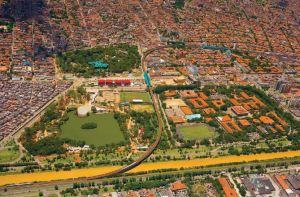
part of Medellín, which has transformed from a
marginal place to the main center of education and culture.
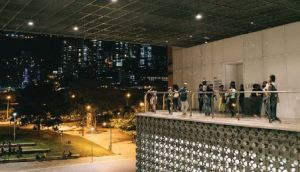
Another example of this transformation is Botero Plaza located adjacent to the Antioquia Museum. This plaza, which is graced with sculptures by the renowned Colombian artist Fernando Botero, is considered a public space par excellence. The northern part of the city has transformed its public spaces as well, establishing Parque Explora science center and the Botanical Garden of Medellín, both of which serve as community anchors. To create these spaces, local architects were invited to express themselves using the best possible architectural design and urbanism.
Other noted examples of Medellín’s adaptive reuse of public space can be seen at the Museum of Modern Art (a converted steel factory) and House of Memory Museum, which remembers the victims of our painful past. And the city’s much-lauded Metrocable—a gondola lift system—which connects remote, isolated hillside communities to the urban center, further demonstrates how infrastructure can aid social inclusion. Mobility is a crucial component of equity.
Today, many communities once burdened by hardships are now flourishing with symbols that dignify their present. The idea is this: dignifying the most deprived areas with facilities of the highest cultural and aesthetic values and missions will generate a different sense of belonging among communities.
Government programs have worked in tandem with urbanism to foster greater social equity and inclusion. For example, the “Buen Comienzo” program seeks to have a strong impact during childhood, the starting point for inequality. In the race of life, many children begin with a disadvantage: as the Colombian human rights leader Héctor Abad Gómez said, we can’t compare the child of a malnourished mother to the child of a well-fed, educated, and working one. This child development program, which provides initial education and promotes the integral, inclusive, and autonomous development of children and their families through customized services to meet unique family needs, today reaches 95,000 children from birth to age 6.
And finally, I would like to highlight the UVAs, or Articulated Life Units, that were launched in 2013. This initiative has redesigned space around water utility tanks that previously prohibited public access and were a lure for vagrants and violence. Today these vibrant cultural hubs boast theaters, libraries, water plazas, and sports arenas that engage the public through a range of recreational, educational, and social activities to enhance the quality of life and well being.
The main source of investment in much of this cultural and urban renewal is Empresas Públicas, the country’s privately administered main public energy company. Annually, it provides a quarter of the city budget through its operational surplus.
On the whole, we can identify the following pillars that undergird this urban laboratory: appropriate fiscal management, social inclusion, urbanism, security and coexistence, and public and private sector investment and participation.
Thus, like a palimpsest, Medellín writes its new history on top of the previous one. Reflected in it is the value of our efforts to overcome the crises we have faced to provide greater opportunities for our people to thrive.







